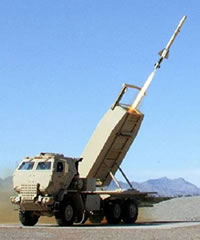Lockheed Martin (NYSE:LMT) unveiled a new missile designated P44, designed to demonstrate a long range high precision strike capability. The P44 is designed for quick precision strike against moving surface targets under any battlefield conditions without minimum range limitations. It is designed to fill the gap in the ability to effectively engage and neutralize long-range artillery, particularly mobile rocket launchers. This compact missile (7-inch (17.8 cm) diameter) weighs 220-pound (100 kg)). It will have an effective range from zero to more than 70 kilometers. It will be launched from an MLRS multiple launch platform, such as the tracked MLRS, GMLRS or therapidly deployable wheeled HIMARS platforms.
The missile uses a fast boost-sustain motor, and terminal seeker capable of operating under adverse weather conditions. The projected warheads for P44 are either a 28-pound Hellfire II Metal Augmented Charge (MAC) or a 17-pound shaped charge with precursor. Ten missiles can be loaded into MLRS rocket pods, stored with their wings folded. The missile uses a mature tri-mode terminal seeker with semi-active laser (SAL) for designated targets; Doppler millimeter-wave radar (MMW) for weather penetration and detection of moving targets; and cooled imaging infrared (IIR) for imaging and discrimination, augmented by Global Positioning System -aided inertial guidance (GPS-INS) for mid-course guidance and.
The P44 missile completed its first flight February 15, 2007 launched from a surrogate HIMARS launcher. Further tests are planned in the near future, demonstrating confirming rocket motor performance, maneuvering and aeroballistics. On April 6th, 2007 P44 made its second test flight last week. In this test Lockheed Martin validated the operation of the missile’s control actuation system and GPS-aided inertial guidance mode for P44. Sofar, the missile successfully demonstrated both boost and sustain operations, stability in cruise mode GPS guidance modes.
















